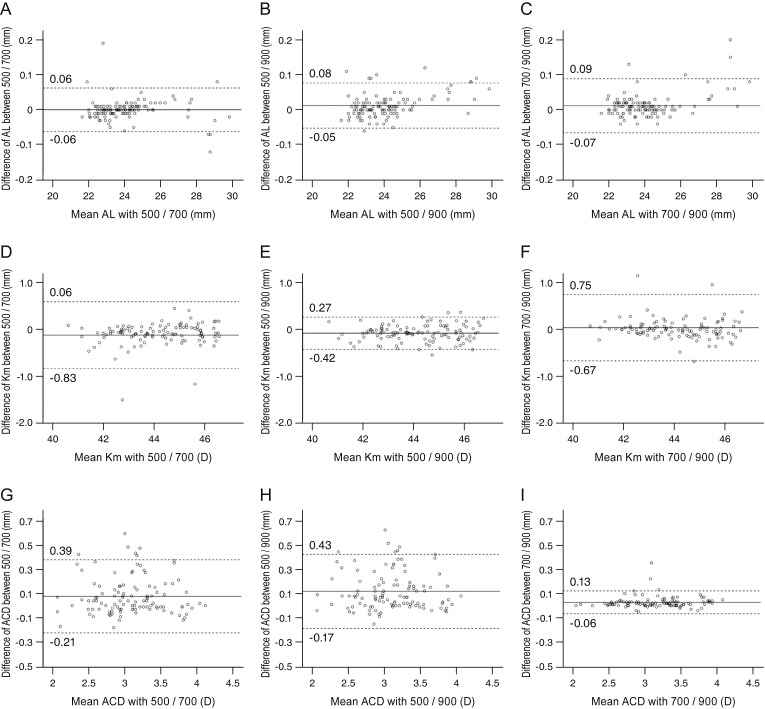Korean J Ophthalmol.
2020 Apr;34(2):126-132. 10.3341/kjo.2019.0102.
Comparison of Ocular Biometry and Refractive Outcomes Using IOL Master 500, IOL Master 700, and Lenstar LS900
- Affiliations
-
- 1Department of Ophthalmology, Seoul National University College of Medicine, Seoul, Korea.
- 2Department of Ophthalmology, Seoul National University Bundang Hospital, Seongnam, Korea.
- KMID: 2507402
- DOI: http://doi.org/10.3341/kjo.2019.0102
Abstract
- Purpose
To evaluate the agreement in ocular biometry outcomes measured by three different devices, the IOL Master 500, IOL Master 700, and Lenstar LS900, and compare the refractive outcomes after cataract surgery obtained using those three devices.
Methods
Medical records of 178 eyes of 89 patients who underwent ocular biometry with the three devices were retrospectively reviewed, and 124 eyes met the inclusion criteria. Paired comparisons were performed for axial length (AL), mean keratometry (Km), and anterior chamber depth and quantified their agreement using Bland-Altman plots. Subgroup analyses were done according to the AL and the Km. Refractive outcomes were compared with respect to absolute prediction errors after cataract surgery in 54 eyes.
Results
Among 124 eyes, 12, 3, and 5 eyes failed to be measured of AL by IOL Master 500, IOL Master 700 and Lenstar LS900, respectively. The AL measured by Lenstar LS900 was longer than that measured by IOL Master 500 and IOL Master 700 (p < 0.001, p = 0.002, respectively). Subgroup analysis revealed that these results were statistically significant only in long eyes (AL >25.5 mm). Km measured using the IOL Master 500 was steeper than that measured with the IOL Master 700 or Lenstar LS900 (p = 0.001,p < 0.001, respectively). anterior chamber depth measured by IOL Master 500 was shallower than that measured by IOL Master 700 or Lenstar LS900 (p < 0.001, p < 0.001, respectively). Ocular biometry measurements by the three devices showed high agreement with narrow 95% limits of agreement. Absolute prediction errors from the 3 devices showed no statistically significant differences after cataract surgery.
Conclusions
The IOL Master 700 and Lenstar LS900 demonstrated superior acquisition rates of biometric measurements compared with the IOL Master 500. Ocular biometry using the 3 different devices showed high agreement, although statistically significant differences were observed; however, since there was no difference in predicting the refractive outcomes, those differences are clinically negligible.
Figure
Reference
-
1. Fontes BM, Fontes BM, Castro E. Intraocular lens power calculation by measuring axial length with partial optical coherence and ultrasonic biometry. Arq Bras Oftalmol. 2011; 74:166–170. PMID: 21915441.
Article2. Shammas HJ, Chan S. Precision of biometry, keratometry, and refractive measurements with a partial coherence interferometry-keratometry device. J Cataract Refract Surg. 2010; 36:1474–1478. PMID: 20692557.
Article3. Vogel A, Dick HB, Krummenauer F. Reproducibility of optical biometry using partial coherence interferometry : intraobserver and interobserver reliability. J Cataract Refract Surg. 2001; 27:1961–1968. PMID: 11738911.4. Akman A, Asena L, Gungor SG. Evaluation and comparison of the new swept source OCT-based IOLMaster 700 with the IOLMaster 500. Br J Ophthalmol. 2016; 100:1201–1205. PMID: 26674777.
Article5. Cruysberg LP, Doors M, Verbakel F, et al. Evaluation of the Lenstar LS 900 non-contact biometer. Br J Ophthalmol. 2010; 94:106–110. PMID: 19692383.
Article6. Olsen T. Calculation of intraocular lens power: a review. Acta Ophthalmol Scand. 2007; 85:472–485. PMID: 17403024.
Article7. Chylack LT Jr, Wolfe JK, Singer DM, et al. The lens opacities classification system III. The longitudinal study of cataract study group. Arch Ophthalmol. 1993; 111:831–836. PMID: 8512486.8. Hirnschall N, Varsits R, Doeller B, Findl O. Enhanced penetration for axial length measurement of eyes with dense cataracts using swept source optical coherence tomography: a consecutive observational study. Ophthalmol Ther. 2018; 7:119–124. PMID: 29498015.
Article9. Buckhurst PJ, Wolffsohn JS, Shah S, et al. A new optical low coherence reflectometry device for ocular biometry in cataract patients. Br J Ophthalmol. 2009; 93:949–953. PMID: 19380310.
Article10. McAlinden C, Wang Q, Pesudovs K, et al. Axial length measurement failure rates with the IOLMaster and Lenstar LS 900 in eyes with cataract. PLoS One. 2015; 10:e0128929. PMID: 26061554.
Article11. Arriola-Villalobos P, Almendral-Gomez J, Garzon N, et al. Agreement and clinical comparison between a new swept-source optical coherence tomography-based optical biometer and an optical low-coherence reflectometry biometer. Eye (Lond). 2017; 31:437–442. PMID: 27834962.
Article12. Hoffer KJ, Shammas HJ, Savini G. Comparison of 2 laser instruments for measuring axial length. J Cataract Refract Surg. 2010; 36:644–648. PMID: 20362858.
Article13. Holzer MP, Mamusa M, Auffarth GU. Accuracy of a new partial coherence interferometry analyser for biometric measurements. Br J Ophthalmol. 2009; 93:807–810. PMID: 19289385.
Article14. Rohrer K, Frueh BE, Walti R, et al. Comparison and evaluation of ocular biometry using a new noncontact optical low-coherence reflectometer. Ophthalmology. 2009; 116:2087–2092. PMID: 19744720.
Article15. Olsen T. Sources of error in intraocular lens power calculation. J Cataract Refract Surg. 1992; 18:125–129. PMID: 1564648.
Article16. Santodomingo-Rubido J, Mallen EA, Gilmartin B, Wolffsohn JS. A new non-contact optical device for ocular biometry. Br J Ophthalmol. 2002; 86:458–462. PMID: 11914218.
Article17. Epitropoulos A. Axial length measurement acquisition rates of two optical biometers in cataractous eyes. Clin Ophthalmol. 2014; 8:1369–1376. PMID: 25092960.
Article
- Full Text Links
- Actions
-
Cited
- CITED
-
- Close
- Share
- Similar articles
-
- Comparison of Ocular Biometry and Postoperative Refraction in Cataract Patients Between Lenstar(R) and IOL Master(R)
- Comparison of Ocular Biometry and Refractive Outcomes Using IOL Master 700, IOL Master 500, and Ultrasound
- Comparison of Ocular Biometry Measured by Ultrasound and Two Kinds of Partial Coherence Interferometers
- Comparison of Clinical Outcomes between Swept-source Optical Coherence Tomography Biometer and Partial Coherence Interferometer
- Comparison of the Refractive Results Measured by Ultrasound and Partial Coherence Interferometers


